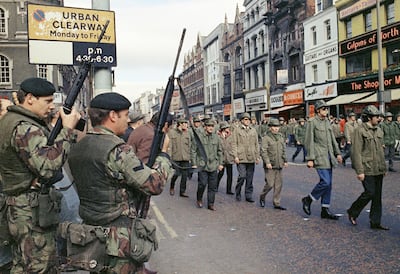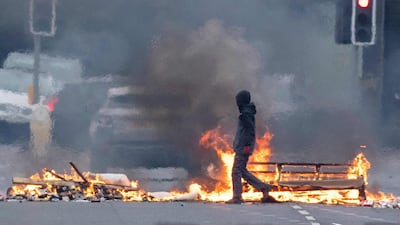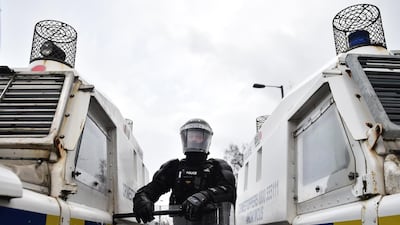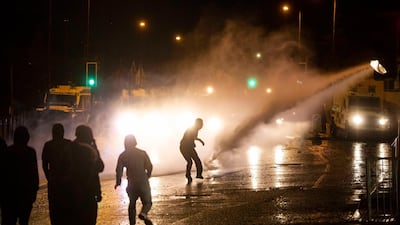You never forget your first bomb. On April 12, 1989, the solid whump of a 680-kilogram car bomb set off by the Irish Republican Army was enough to stop me and my classmates at St Peter’s Boys’ School dead in our tracks.
Our heads snapped right, watching the growing cloud of smoke rising from Charlotte Street, the site of our little town’s fortified police barracks. That blast – which I remember more as a feeling than a sound – killed Joanne Reilly, 20, who had been working in Heately & Morgan’s hardware shop beside the station belonging to the RUC, the local police force. It also injured nine police and 31 civilians.
Less than a kilometre from this rending confluence of history, politics and ordnance, just past the town square and out in Carlingford Lough, was – and is – the Border, which turns 100 next week.
Let’s give it a capital B - it deserves that much. Forests have been felled to print all the books written about how Ireland came to be partitioned on May 3, 1921 – six counties remaining in the UK as Northern Ireland, and the other 26 becoming an independent Irish Free State, and later, the Republic. You don’t need me to tell you that old story again.
For me, the Border – that snaking, 500km frontier that cuts across roads, bridges, fields, rivers, farms and even houses – was my country’s turbulent history made manifest. But it manifests in different ways. When I was young, the Border could be invisible. It started somewhere out there in the lough, although there is still some “jurisdictional ambiguity” as to exactly where. It ran up the Newry River just past Narrow Water, the scene of another IRA bombing in 1979, before taking a hard left and splitting a country road at the wee bridge on the bend before Cornamucklagh.
But there were enough little reminders that the Border was real. Sitting on the shore one afternoon as a teenager, I was surrounded by a unit of black-clad Royal Marines who piled on to the beach from the British patrol vessel lurking out in the lough. Despite Boris Johnson’s breezy, Brexit-related claim in 2018 that our Border was essentially just like the one between Camden and Islington, I doubt many Londoners are often face to face with combat troops.
Years later, I was lucky enough to be working as a local journalist on the Border as the changes wrought by the Good Friday Agreement came to pass. I was there in July 2000 when British army engineers removed their paint-splattered fortification from the centre of Crossmaglen in South Armagh – a region where the Border could be divined from a twisting line of bases and hilltop watchtowers, all bristling with surveillance technology.
The bombs and soldiers and shootings and hunger strikes and hooded bodies left in lonely ditches are largely gone now, and, until recently, the Border had been quietly disappearing into irrelevance as the Agreement – it, too, takes a capital letter – endured and common EU membership smoothed out the remaining differences.

But Brexit has done quite the job of reanimating our spectral Border, piling more political, economic and constitutional complexity on to a conflict the 1998 treaty had parked for another generation to figure out.
In Clare Dwyer Hogg’s 2018 short film Hard Border, Belfast-born actor Stephen Rea described how 1998 “and all the years in between” helped make the frontier disappear: “There but not there, a line of imagination that needed imagination to make it exist while unseen.”
Frontiers require imagination. You are standing on the same earth, but people have names and identities and states to partition it. This gives borders, especially disputed ones, the psychic strangeness of boundary places.
This left its impression on me, like a thumbprint in my mind. I’ve peeked through the rusty barriers pulled across the beach in Varosha that divides Turks from Greeks in Cyprus, and felt right at home. Jerusalem and Hebron were studies in razor-sharp, micro-managed partition – down to every house, plot of land and street corner.
I wish I could say that these outside experiences of partition had left me more phlegmatic about Ireland being divided. But, growing up where and how I did, the Border still instinctively strikes me as an aberration in the island home of my imagination. It took me a long time to appreciate that for my unionist neighbours, the anomaly in Ireland is the Republic that broke away from the mothership.
Will partition in Ireland come to an end? I don’t know. Perhaps, if enough of us want it to and the time is right, is my best answer. What will endure are the memories of 30-odd years of violence. Certainly, the ‘89 bombing has followed me down the years. On December 10, 2016, I was in Istanbul and the crump of a double explosion in nearby Besiktas made me jack-knife out of bed, my heart hammering much as it did 27 years before.
Even for those who didn't experience the Troubles directly, the violence has a long, malignant half-life. A 2017 study from Queen's University Belfast found that "the impact of the conflict remains and affects communities and generations".
And now, a new generation is getting its first taste of violence. Recent rioting by working-class loyalist youths in Belfast, Derry and elsewhere – fuelled by a mix of deprivation, Brexit-related anxiety, a controversial IRA funeral plus paramilitary manipulation – shows how combustible Northern Ireland still is.
The centenary of Ireland’s division will come and go. A BBC poll on April 21 found that just 40 per cent of people in Northern Ireland thought the state’s foundation worth celebrating. Unionist politicians will dutifully do their best to mark it, with some underwhelming input from a British government with bigger fish to fry. The centenary will be studiously ignored by Irish nationalists, many of whom still feel the “national question” remains unresolved.
So be it. What comes to my mind is the cries of the curlews flying over Carlingford Lough. They take wing against the backdrop of the Mournes and Cooleys – solemn mountains that will be there long after we, our maps and our borders fade from history, as if we were never there.
Declan McVeigh is a sub-editor at The National










